Early Power Distribution Stations
LADWP, like most electric utilities, uses distribution stations to transfer power from the transmission or sub-transmission systems to the distribution system of an area. It is uneconomical to directly connect electricity consumers to the main transmission network, unless they use large amounts of power. Therefore the distribution station reduces voltage to a value suitable for local distribution. In addition to transforming voltage, distribution substations isolate faults in either the transmission or distribution systems and are also used for voltage regulation. They play a major role in maintaining a high level of power quality and system reliability,
As Los Angeles began to grow and spread out in the early 1900s, there became an increasing need to install additional distribution stations throughout the City. The following is just a sample of some of the earlier distribution stations of the 1920s and 1930s.
Early Distribution Stations in Los Angeles
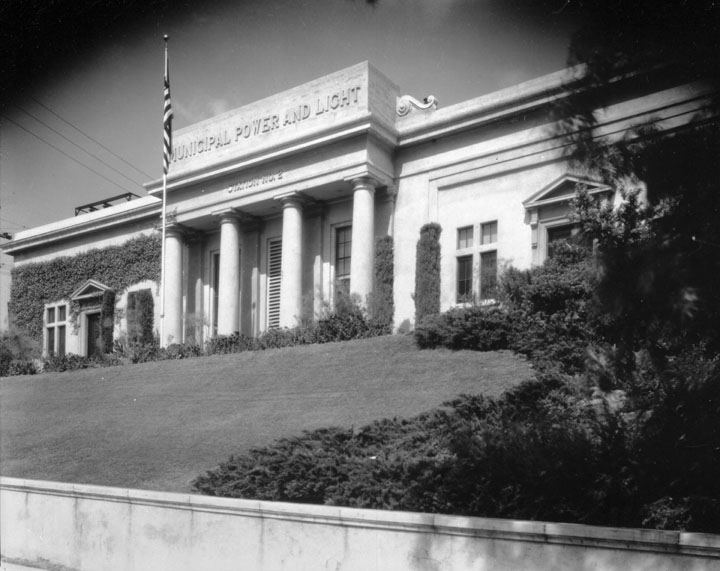 |
|
| (ca. 1920s)* - Distribution Station No. 2 - 225 North Avenue 61 |
 |
|
| (ca. 1920s)* - Distribution Station No. 3 - Harbor Boulevard and Regan Street, San Pedro |
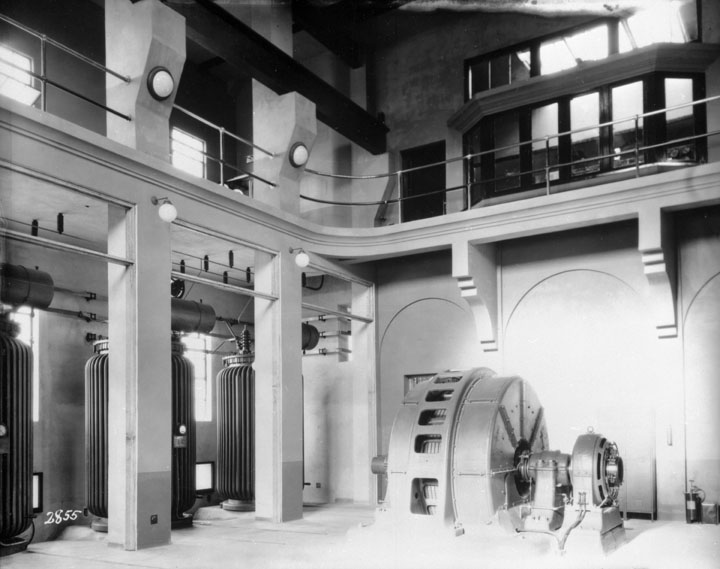 |
|
| (ca. 1920s)* - Distribution Station No. 3 - interior shot |
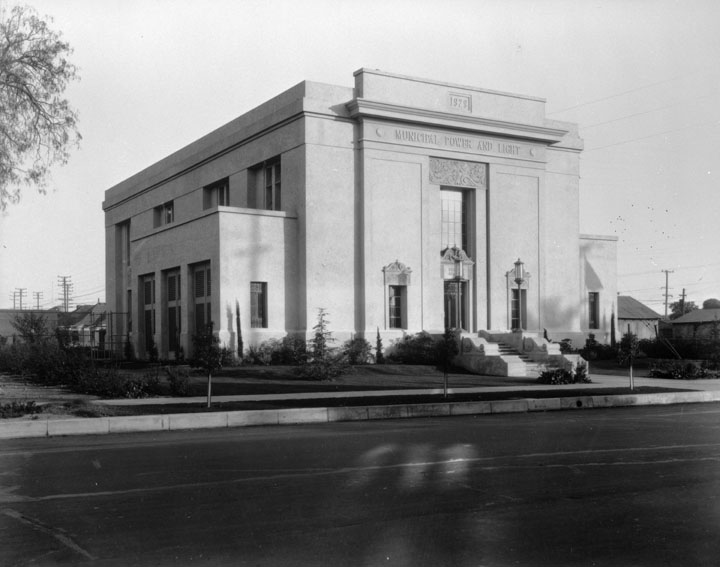 |
|
| (1928)* - Distribution Station No. 4 - 5736 South Figueroa Street |
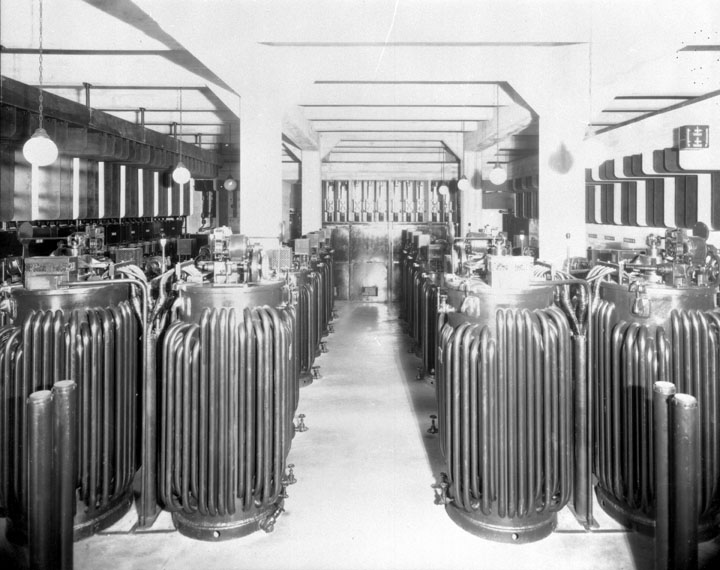 |
|
| (1928)* - Regulators at DistributionStation No. 4 |
 |
|
| Distribution Station No. 5 - 1504 Mateo Street |
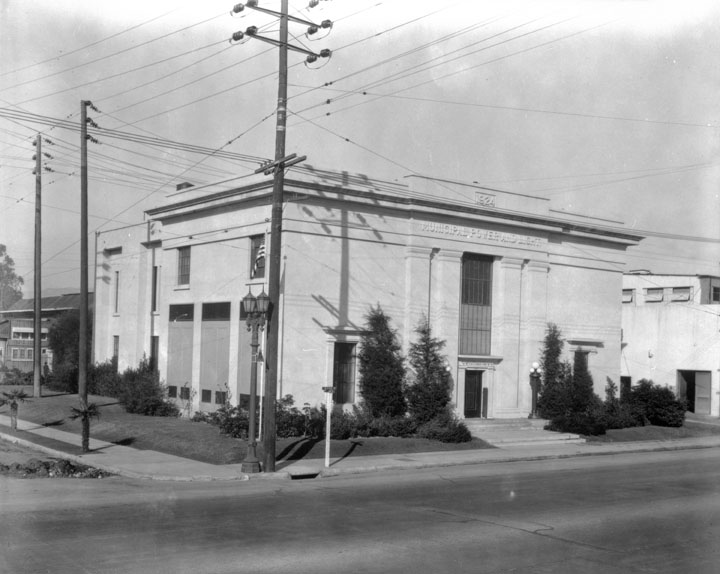 |
|
| Distribution Station No. 6 - Vine and Romaine, Hollywood |
.jpg) |
|
| (1963)* - View of Distribution Station No. 7 located in the Civic Center. |
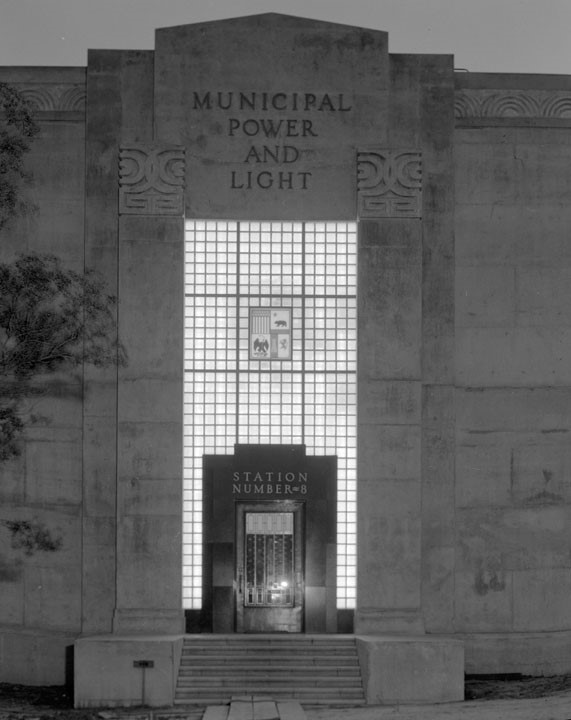 |
|
| (1940)* - View showing the illuminated entrance to Distribution Station No. 8 located at 4858 San Vicente Boulevard, corner of Longwood Avenue. |
LADWP Historic Archive
September 1938 – Preliminary construction work is scheduled to get under way this month on one of the largest distributing stations ever built by the Bureau of Power and Light.
Estimated cost of the project is $646,000, with $195,000 to be expended on the building. $16,000 on appurtenant work which includes a steel reinforced retaining wall around part of the property, and $435,000 for electrical equipment, it was stated by H. C. Gardett, assistant Chief Electrical Engineer and General Manager of the Power Bureau.
To be designated as Distributing Station No. 8, the new station will replace a semi-permanent type station which occupies the rear portion of the lot at 4858 San Vicente Blvd, corner of Longwood Ave. it will serve the Hancock Park and West Pico Districts.
Consisting of two main floors and basement, ground dimensions of the building will measure 122 ft. in length by 51 ft. in depth. Built of reinforced concrete on a steel frame, the structure is designed to be completely fire and earthquake proof.
Structural details were worked out under supervision of C. P. Garman, assistant engineer of design.
The front of the building will be particularly noteworthy because of its modernistic treatment. A wide panel rising over the doorway will be fabricated of glass building brick to a height of about 37 ft. The entrance will be trimmed with polished black granite.
The station will be built in two sections. The front portion first will be erected, and equipment moved in from the existing station, which then will be razed. The second section of the structure then will be built. All work will be done by Design and Construction Division forces under R. R. Robertson, engineer of construction. G. E. Benkesser will be in charge of the field forces.
The station is designed for an ultimate capacity of twelve 34,500 volt lines, thirty-one 4,800 volt feeders and ten street lighting regulators. Two synchronous condensers also will be part of the station’s electrical equipment. All 34,500 volt and 4,800 volt lines will enter the station through underground conduits.
Filtered air is circulated throughout the building and the operating room is the first in any Bureau distributing station to be air conditioned. Electric strip heaters located in the basement will warm the air during winter months. Other innovations in design are: installation of capacitors on all 34,500 volt lines; remote control on all auxiliary switches; separate room for relay equipment, and ventilators on all buss chutes to prevent accumulation of gasses.
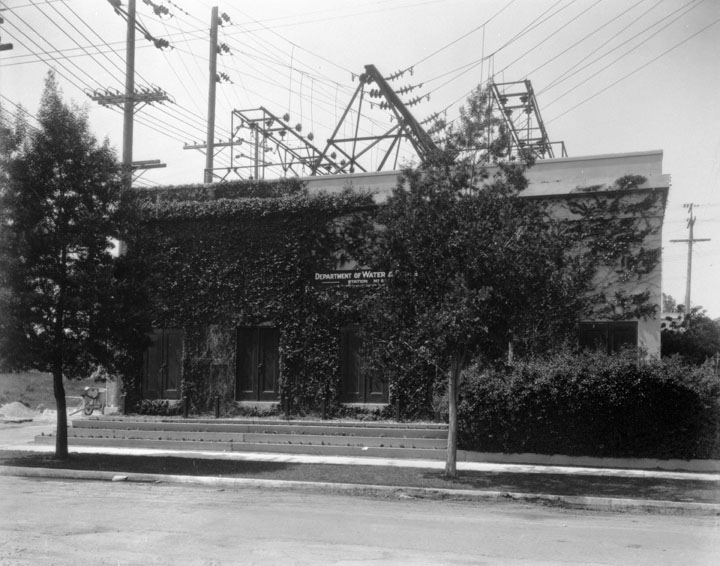 |
|
| (n.d.)* - Side view of Distribution Station No. 8 - 1389 Longwood Avenue |
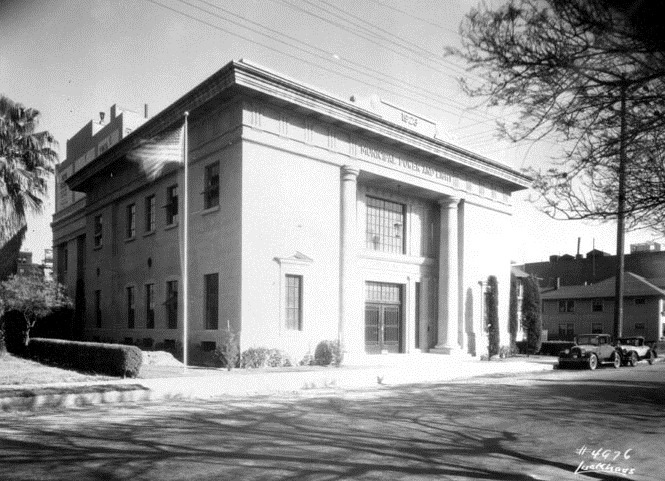 |
|
| Distribution Station No. 9 - Francisco Street |
.jpg) |
|
| (1933)* - View of the front entrance to Distribution Station No. 10, located at 6776 Hawthorne Avenue in Hollywood. |
LADWP Historic Archive
May 1933 – Another vital link was added to the chain of equipment supplying light and power to Los Angeles when Distributing Station No. 10 was put into service April 20, 1933. The new addition to the Bureau of Power and Light system is located at 6776 Hawthorne Ave and will serve the important west and central sections of Hollywood.
New features that have been used in the station, in accordance with the Department’s policy to use modern, approved methods and equipment, include miniature type control and metering switchboard equipment, metal clad switchgear for the for the 4,600-volt busses and three-phase power transformers with wiped-on leads.
Close coordination among the staff of H. C. Gardett, engineer of design and construction, is credited with making the $400,000 project a model of its type among distributing stations of the country. Working with M. O. Bolser, engineer of design, in planning the station were C. P. Garman, Oscar Wingard, engineer of distributing stations, and James Laughlin, who was the engineer in immediate charge of the work.
Headed by R R. Robertson, engineer of construction, building forces were supervised by R. B. Keese, general building foreman, and George Manhart, general electrical foreman.
Modern architectural treatment of the building façade has created a structure that is an asset aesthetically as well as practically to the community it serves. Consisting of two stories and basement, the building is constructed of structural steel frame, braced to withstand horizontal stresses such as occur in earthquakes, with reinforced concrete walls, floors, and roof.
Inside the building, the first object in view is what might be the console of a technocratic pipe organ (see photo below). It is the first control and meter board ever built using miniature design control switches, instruments and indicating lamps. By means of this new design control board which is of the circular desk type with the instrument panels directly back of it, the operator can reach all control switches and read any of the instruments without moving from his chair. Power Bureau engineers are to be credited for technical ability and initiative in planning and building this novel board which affects notable savings in building space, material and cost of equipment.
By designing meter circuits to operate on one-tenth ampere or less and control circuits on one ampere or less, it was possible to use smaller wire for all control and metering circuits. The wire used was No. 16 gage, rubber insulated and lead sheathed. Additional savings in copper and conduit sizes resulted from use of this control cable.
The station has the distinction also of having two power transformers that are the largest and highest in voltage of their type on the coast. The transformers have no external bushings, all leads being taken into the cases in lead sheath cables, with the sheaths wiped directly to the transformer case. They are 7,500 KVA, 33,000 volts to 4,600 volts, three phase, oil insulated, water cooled, cushioned with inert air in the space above the oil level.
The first metal clad switch gear in service in this vicinity is utilized for the 4,600-volt bus. All current carrying parts are entirely enclosed in sheet metal housings. The bus structure is factory assembled in units, mounted on a steel frame and metal enclosed. These sections are moved into the station, bolted together and wired to the external circuit.
Maximum continuity of service to consumers has been a prime consideration throughout the entire station design. With two 33,000 volt lines from Station No. 6 and one from Station No. 8, the new station can be fed from the Power Bureau’s hydro-electric generating plants through the “A” system, or from the Southern California Edison Company’s lines through the “B” system. Automatic operations pick up station load from line to line without interrupting service.
A 240 ampere-hour storage battery controls and operates circuit breakers by direct current, making operation independent of outside electrical supply.
The congestion of poles and lines frequently found in the vicinity of distributing stations has been eliminated by having all transmission lines and feeders enter and leave the station underground. Present installation provides equipment for three 33,000 volt lines, two 7,500 KVA three-phase transformers and seven 4,600 volt regulated feeders. Ultimate capacity of the station will be six 33,000 volt lines, four 12,500 KVA transformers, 32 4,600 volt feeders and eight street light circuits.**
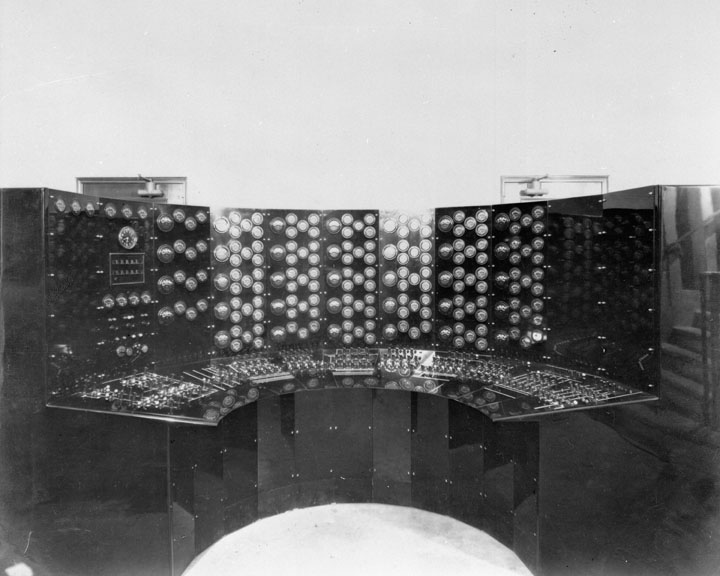 |
|
| (1933)* - Distribution Station 10 - Meter and control board which is a new type designed and built by the Bureau of Power and Light. This equipment resembles the console of a huge pipe organ. |
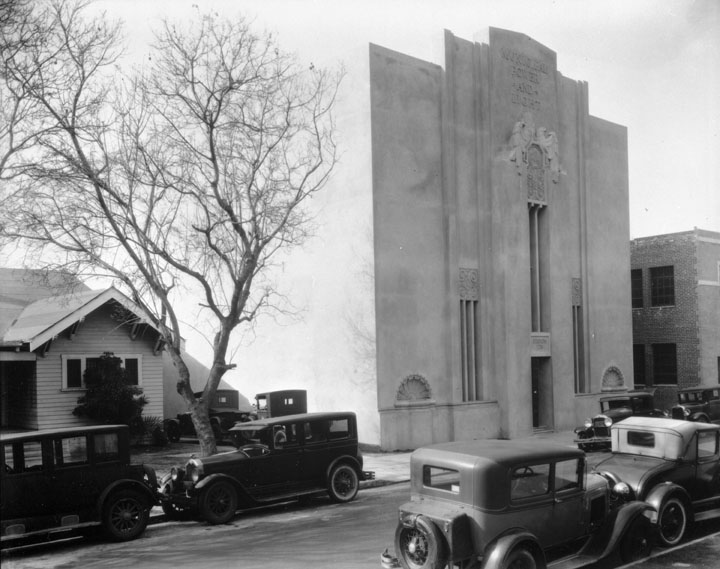 |
|
| (1933)* - Another view of Distribution Station No. 10. |
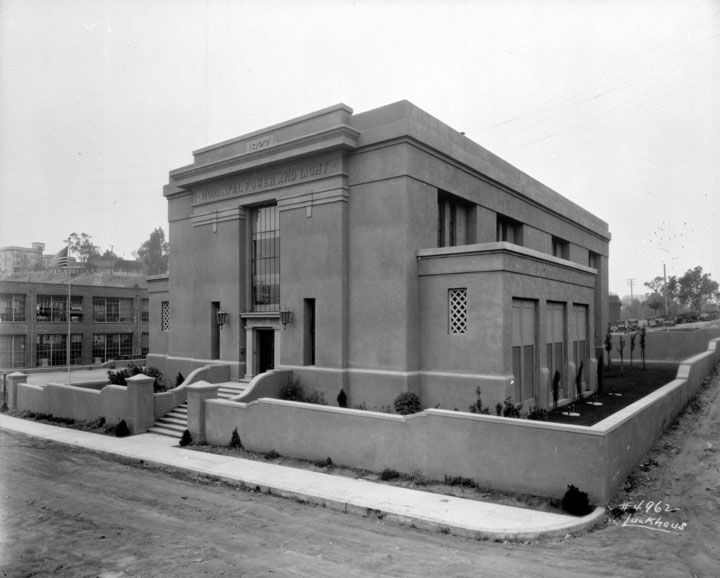 |
|
| Distribution Station No. 11 |
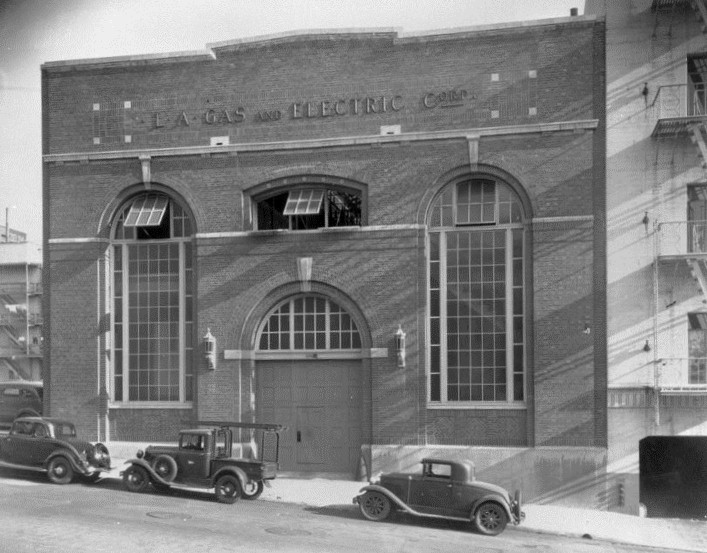 |
|
| (1927)* - Distribution Station No. 12 at 120 East Fourth Street. This station was built by LA Gas and Electric Co. which was purchased by the Los Angeles Bureau of Power and Light in 1937. |
LADWP Historic Archive
November 1927 - constructed and all cable installed under the direction of Mr. W. M. Dudley, General Underground Foreman.
The cable at this site is one million, five hundred thousand circular mill area, and furnishes direct current for the down town business district. It also supplies elevator service and the power to operate moving picture machines in the larger theatres, and in many cases is used as an emergency supply in the event of the failure of the alternating current.
This direct current is distributed over the district in a network, feeding into junction boxes located at every street intersection.**
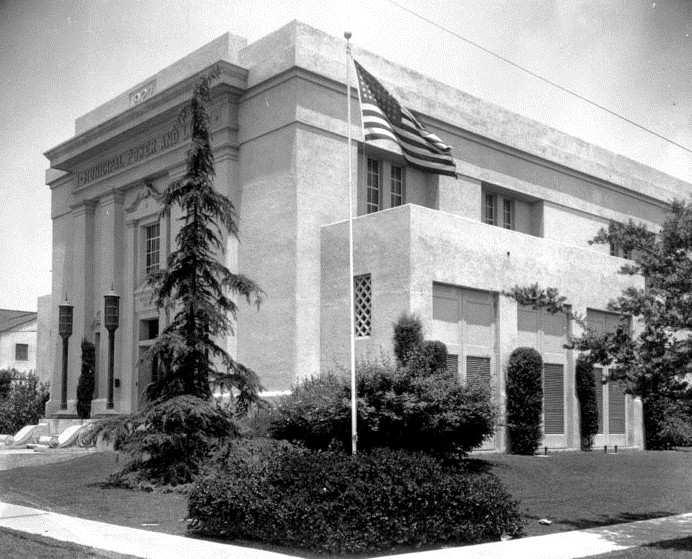 |
|
| (1928)* - Distribution Station No. 13 |
LADWP Historic Archive
May 1928 - One of the objectives of the Engineer is to arrive at a standard type of building and a standard electrical layout that will meet both the architectural and load requirements of the diversified centers of population throughout the city of Los Angeles. at 3520 South Normandie Ave one may now see in operation the new Distribution Station No. 13 – which is representative of the very latest type of a standardized station, as developed for the Bureau of Power and Light system. Credit is to be given J. D. Laughlin for his efficient supervision of the engineering details of this plant. Five stations, of which Station 13 is the fifth, have been constructed from one set of drawings, thus effecting a great saving not alone in engineering and drafting expenditures, but also in actual construction costs, because the crews have become familiar with the standardized layout and accomplish results with greater efficiency and precision.
The first cost is not the only item benefited by uniform construction, for experience has proven that subsequent operations are simplified and improved, and maintenance costs reduced thereby. Station No. 13 was placed in operation during the month of March (1928) with an installed transformer capacity of 10,000-Kva, and furnishes energy for nine regulated 4600-volt feeders and six street lighting circuits. The six 33,000-volt lines entering the station and all outgoing feeder lines are carried into and from the building through underground ducts. This is the first station to be placed in operation with complete elimination of all overhead lines – a feature which will simplify line maintenance and improve the appearance of the station grounds and adjoining streets.
In selecting a type of building for the standard station, the architect adhered to the Grecian edifice which, in its massiveness, simplicity and symmetry, symbolizes the permanence, the utility, and the stability of the electrical system.
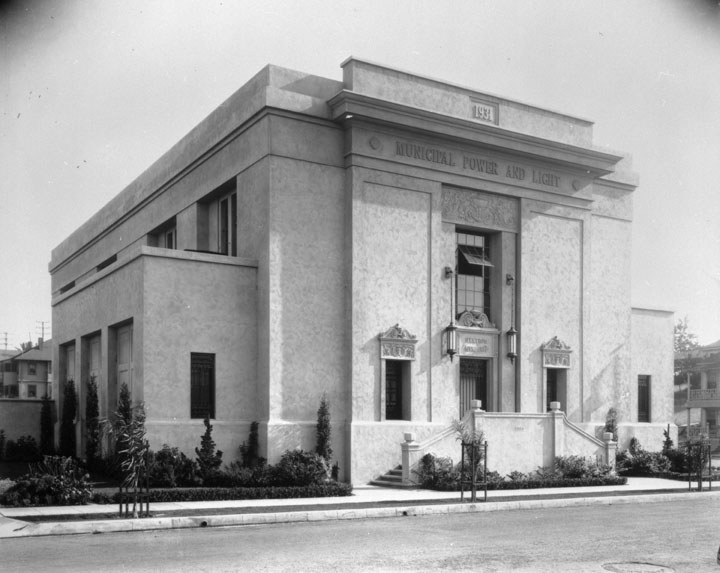 |
|
| (Early 1930s)* - Distribution Station No. 17 |
LADWP Historic Archive
Distributing Station No. 17 at 2904 West 11th Street - Ground was broken last month, (July 1930) for the new Distributing Station Number 17 which will replace the temporary sheet iron structure at 2940 West Eleventh.
Station No. 17 will serve electrical energy for power and lighting to the territory included between Western Ave., Vermont Ave., Sixth Street, and Pico Street.
The design of the new building is the Classic type of architecture, using decoration of cast stone and ornamental iron. The exterior finish will be buff stucco.
The grounds surrounding the building will be planted with lawn, flowers and shrubs.
The main section of the building will consist of a basement and two stories each with a floor area 46 feet by 100 feet. On each side of the main section at the front of the building will be a one story transformer room 12 feet by 36 feet. The maximum height of the building above grade will be 40 feet 8 inches.
The building will be constructed with a structural steel skeleton and concrete floors and walls.
The initial building installation will provide space for 8 – 33,000 volt lines, two power transformer banks, 24 – 4,600 volt regulated feeders, 20 regulated street light feeders, 2- 5,000 Kva. Synchronous condensers and all necessary control and auxiliary equipment. There is space on the property for a future extension of the building to provide space for 8 additional regulated 4,600 volt feeders.
The initial electrical installation will include 4 – 33,000 volt line, 1 – 10,000 Kva transformer bank, 1 – 7,500 Kva transformer bank, 9 – 4,600 volt regulated feeders, 6 – street light feeders and necessary control and protective equipment.
The estimated building cost is $123,000.00 and the electrical equipment is $285,000.00.
On the same property adjoining the station there will be erected a Troubleman’s Headquarters building, containing an office, garage space for three cars and locker space for tools. This building will be the headquarters for troublemen serving the territory adjacent to Station No. 17.
The architecture and finish of this building will be such that it will harmonize with the station building.
The new station was designed by the sub station section under the direction of O. Wingard.**
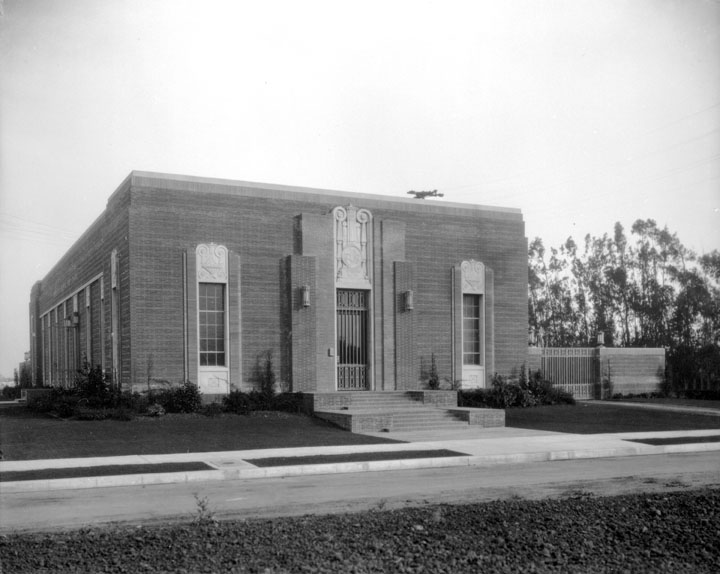 |
|
| Distribution Station No. 20 - Palms |
LADWP Historic Archive
April 1933 – preliminary work under way at Distribution Station No. 20 site in Palms, at Kincardine and Canfield Avenues, includes erection of a small bridge across a swampy depression and laying of water mains. Oliver H. Wenty, engineer of this job for Wingard, states that securing of a building permit has been delayed temporarily due to changes in layout.
May 1933 – Another Power Bureau project was launched April 10th when a gas engine driven shovel dipped into the earth at the site of Distributing Station No. 20, 3030 Canfield Ave, and commenced loading a fleet of waiting trucks.
By the end of the month R. B. Keese, construction superintendent in the Design and Construction division, expected to have 25 men at work on the $211,000 structure. George Manhart, general electrical foreman, planned to have a smaller group of electricians started by the same time. Definite arrangements for beginning detailed construction depended upon the date of securing a building permit, according to Oliver Wenty, engineer in Oscar Wingard’s station design section.
The new station will serve an area bounded roughly by Overland Ave, Pico Blvd, Hauser Blvd and the Los Angeles City boundary south of Culver City. This district now is served from Sawtelle Distributing Station No. 28. By shortening the transmission distance, possibilities of service interruption are lessened.
Engineers state that the new station should be in operation before the end of the year.
February 1934 – With all structural work completed, only the installation of electrical equipment is required before Distributing Station No. 20 is added to the Power Bureau’s distributing system.
Electric mechanics, under the direction of H. J. Rice, are working on miscellaneous electrical equipment, awaiting the purchase of the large 33,000 volt oil circuit breakers. When they are secured the station will be completed soon afterwards.
Located at 3030 Canfield Ave, the station will provide additional service facilities to the Palms district. A feature of the plant is the installation of the second miniature type control and meter board in the municipal system, following the successful operation of the first of its type at station no. 10 in Hollywood.
As the result of an organization change last November in the Design and Construction Division, G. E. Benkesser is in charge of the station construction. Reporting to R. R. Robertson, engineer of construction, Mr. Benkesser supervises all electrical, structural and mechanical construction work in connection with receiving, distributing and industrial stations and all other buildings.**
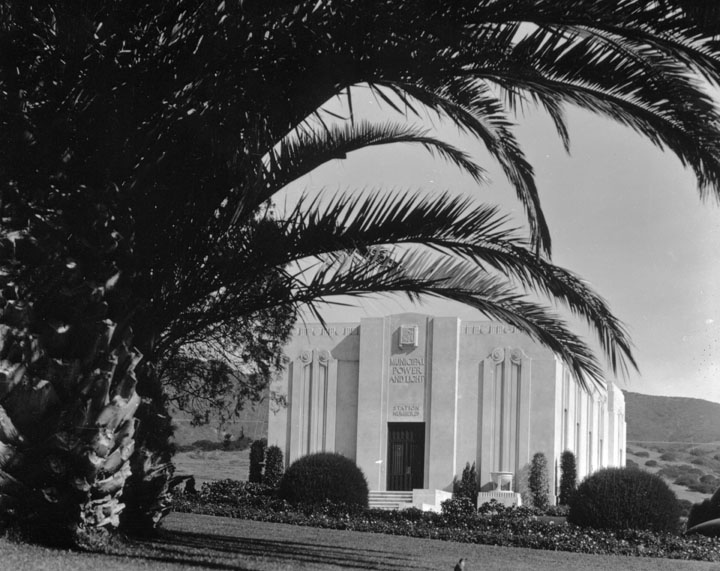 |
|
| 1935)* - Distribution Station No. 29 - 15345 Sunset Boulevard |
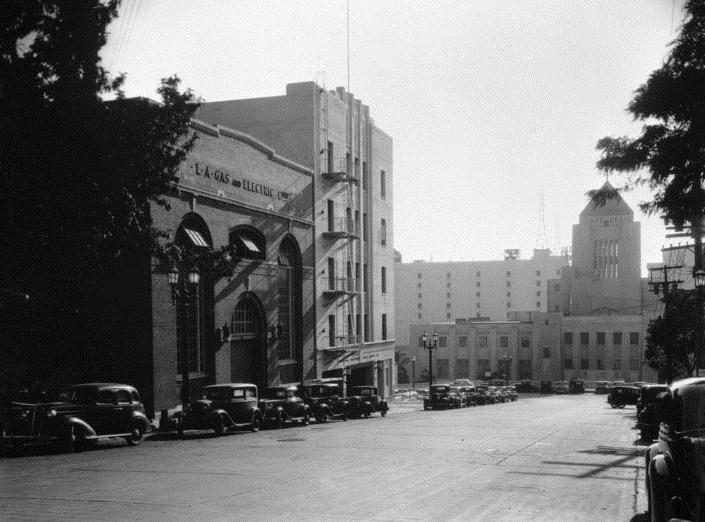 |
|
| Distribution Station No. 42 - 428 South Hope Street. This station was built by LA Gas and Electric Co. which was purchased by the Los Angeles Bureau of Power and Light in 1937. |
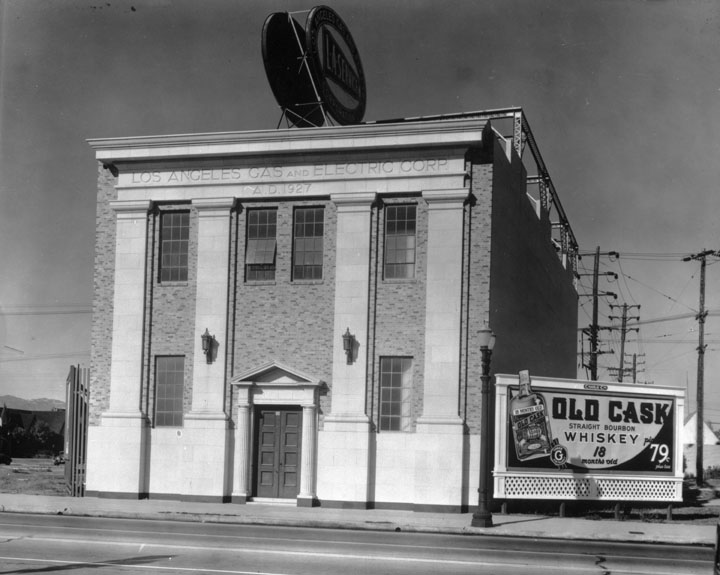 |
|
| Distribution Station No. 43 - 5769 West Pico. This station was built by LA Gas and Electric Co. which was purchased by the Los Angeles Bureau of Power and Light in 1937 (See the Historical Timeline in the First Electricity in Los Angeles Section). |
* * * * * |
History of Water and Electricity in Los Angeles
More Historical Early Views
Newest Additions
Early LA Buildings and City Views
* * * * * |
References
* DWP - LA Public Library Image Archive
**LADWP Historic Archive
..Electricity in Brick, Concrete, and Stone: DWP Distribution Stations No. 1-20
< Back
Menu
- Home
- Mission
- Museum
- Mulholland Service Award
- Major Efforts
- Board Officers and Directors
- Positions on Owens Valley and the City of Los Angeles Issues
- Legislative Positions on
Water Issues
- Legislative Positions on
Energy Issues
- Recent Newsletters
- Historical Op Ed Pieces
- Membership
- Contact Us
- Search Index